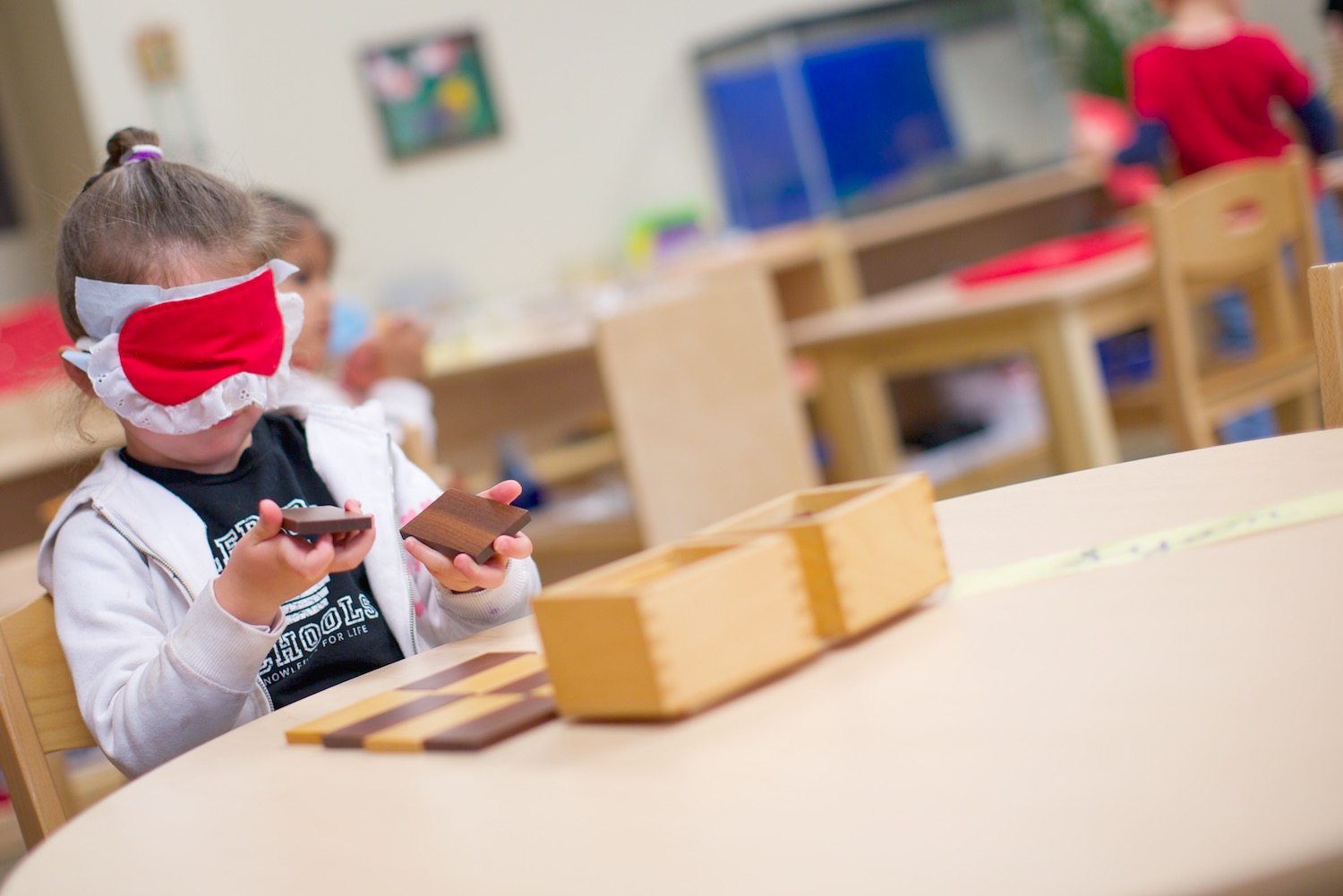
Developing Active Minds, Concentration Skills and Powers of Observation
The main purpose of the Sensorial Area is to enable the child to acquire mental skills and habits that enable her to learn readily and joyfully for the rest of her life.
Dr. Montessori recognized that the child’s reasoning mind needs specific training and preparation, and that the first step is to help the child develop the habit of focusing and concentrating for sustained periods of time. Through years of observation, she came to see that the only way to help a child acquire the capacity to sustain concentration is to provide him with fascinating materials, materials which would draw his natural interest. It is in the act of losing himself in the task—manipulating the materials with his hands to achieve a specific cognitive purpose—that a child develops the mental stamina and skill involved in concentrating over time.
The Montessori Sensorial Materials are designed to build on this insight. They enable the preschool child to develop the capacity to be active-minded, to sustain concentration over long periods of time, and to exercise sharp powers of observation. In a word, the Sensorial Materials provide him with a firm cognitive foundation for his journey of becoming a careful observer and an independent, conceptual thinker.
What We Teach
Self-Correcting Materials Which Stimulate Careful Observation and Classification of Ideas
The Sensorial Materials consist of a wide range of materials that the children work with independently. Each material is designed to isolate a specific tangible quality of a thing, such as its height, length, color or smell.
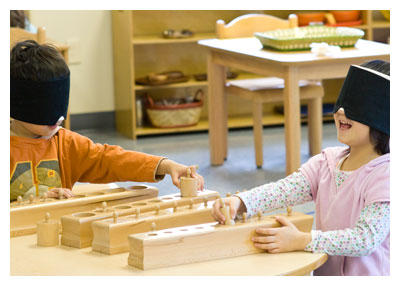 Differentiating dimensions and ordering by size. This
group of exercises includes the materials known as the Pink Tower,
Brown Stair, Red Rods, and the Knobbed and Knobless Cylinders.
Differentiating dimensions and ordering by size. This
group of exercises includes the materials known as the Pink Tower,
Brown Stair, Red Rods, and the Knobbed and Knobless Cylinders.
The knobbed cylinders, is a set of four oblong blocks of natural colored wood. Each block contains ten cylinder-shaped insets (with knobs on top) that can be removed and reinserted by the child. The cylinders vary in height and width. In one block, only the width changes; in another, the height; in the third, both increase together; and in the forth, the height decreases as the width increases. A child works with these materials by removing the cylinders, mixing them up, and replacing them in the proper holes. If he makes a mistake, for example, by placing a thinner cylinder in a hole that is too big for it, he will discover his error on his own. In the words of Dr. Montessori: “In the end, there will be a cylinder left over that cannot be fitted into the still empty hole. . . . His attention is brought sharply to bear upon an obvious problem. He must take out all the wrongly place cylinders and put each of them back into its proper place.”
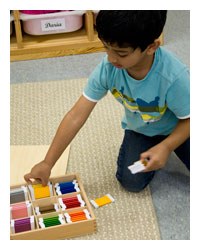 Training all senses to discriminate fine differences. These
materials include the Smelling Jars, the Baric Tablets, the Musical
Bells, the Sound Boxes, the Object Bag, the Swatches and the Color
Tablets.
Training all senses to discriminate fine differences. These
materials include the Smelling Jars, the Baric Tablets, the Musical
Bells, the Sound Boxes, the Object Bag, the Swatches and the Color
Tablets.
The Color Tablets, for example, are a set of small wooden rectangles covered in different shades of colors, contained in two boxes each containing sixty four colors, that is, eight different tints, each of which has eight shades graded from lightest to darkest. Initially, the teacher offers a few bright shades for the child to pair. Next, the child progresses to pairing a dozen shades, then to sorting all sixty-four in neatly arranged rows of gradation—and later, to picking out one particular shade and finding something in his environment that corresponds exactly to it. As his skill in identifying and grouping colors improves, so his attentiveness to his environment increases, and the joy he receives from the exercise multiplies. Dr. Montessori observes: “The children are very fond of this exercise in ‘color memory’; it makes a lively digression for them, as they run with the image of a color in their minds and look for its corresponding reality in their surroundings. It is a real triumph for them to identify the idea with the corresponding reality and to hold in their hands the proof of the mental power they have acquired.”
Understanding basic geometrical shapes and solids. The geometry materials in our primary classrooms include a set of wooden geometric solids (such as spheres, cylinders and prisms); the geometric cabinet (which includes flat wooden insets representing different types and sizes of geometric shapes, such as triangles, rectangles and circles), and constructive triangles (flat triangles of different sizes with which the child can construct all manner of straight-lined geometrical shapes.) Our students handle these shapes, learn their names (such as “rectangular prism”) as part of their vocabulary work, and thus build a concrete foundation for the later study of geometry: it is much easier for a child to understand what a prism is when she can hold it in her hand.
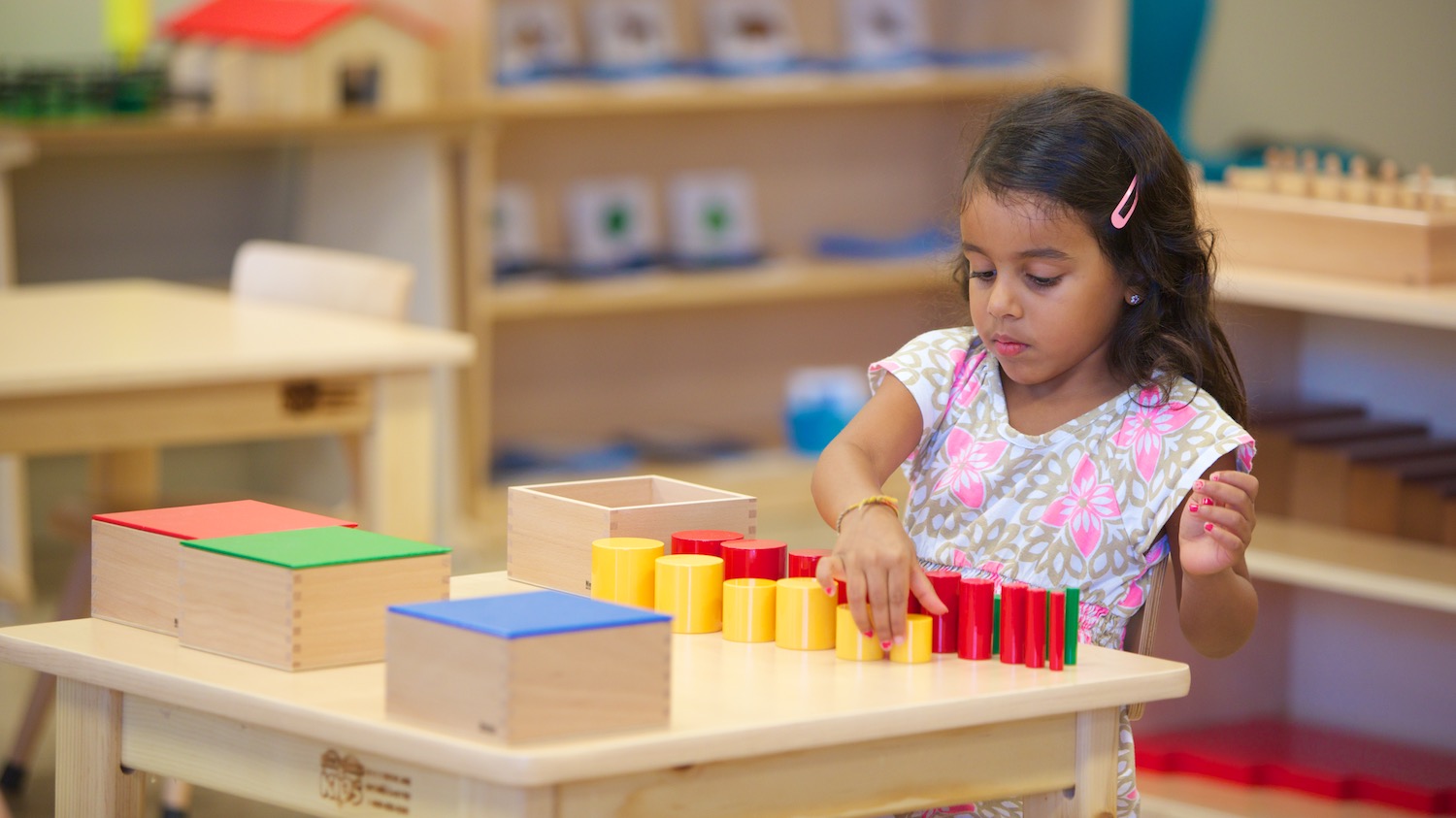
What We Deliver
Active Minds, Concentration Skills and Independent Thinkers
By working with the Sensorial Materials, LePort students acquire the mental skills and habits which enable them to learn readily and joyfully for the rest of their lives. The materials do not offer the child the content of the mind, but order for that content, and enable them to learn and practice a systematic process for paying attention, observing, comparing and classifying. Through the Three Period Lessons, the child fixes the ideas he has acquired in his mind by means of exact, specific words. As a result, in Dr. Montessori’s words:
Children are able to “find themselves,” alike in the world of objects and of words which surround them, for they have an inner guide which leads them to be active and intelligent explorers instead of wandering wayfarers in an unknown land.
By the time they graduate from our preschool program at age 5 ½ to 6 ½, our students have acquired the fundamental skills for a lifetime of learning. They are sensitized to external observation. They learn to observe carefully, and as a result habituate the capacity to take in information about the world. They have the mental discipline and stamina to see a cognitive process through to its end. And, as a result, they have an inner confidence in the power of their mind, and a deep desire to apply that mind in action, a desire which fuels a lifetime love of learning.
Specifically, our 6-year-olds have learned, practiced and habituated:
- Concentration and focus – the ability to actively work with a material for 30, 45, 60 minutes or even longer, without needing adult supervision or help.
- Finely-tuned powers of observation – the ability to differentiate slight gradations of size, color, sound, musical pitch, smell, weight, texture, and a habituated awareness of the external world.
- Persistence, a pro-effort attitude and problem-solving skills – the confidence in her own ability to solving problems, by exerting effort and staying with a challenge until she masters it; and the pleasure of repeatedly experiencing a challenging problem solved by her own efforts.
- A conceptual approach to the world – the ability to form abstractions, such as the concept of length, or circle, or musical pitch, and the mental habit of filing knowledge in her mind in useful, accessible categories.
- Reality-focused, independent thinking – the predisposition to look to the world, not to people, for answers – that is, the understanding that a problem does have a solution, and that he can solve it, but that he must look for the answer in the nature of the things he deals with, not in his or other people’s feelings.
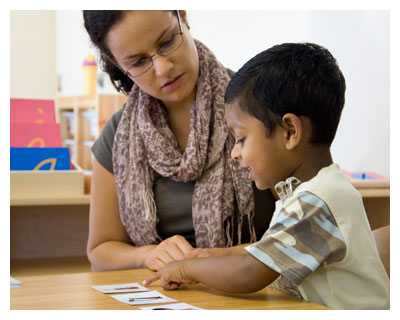
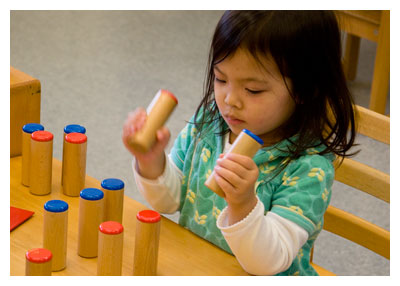 Self-correcting property. The
Sensorial Materials are designed such that the “control of error” lies
in the material itself, and not in the teacher. Thus, as the child
inserts the knobbed cylinders into their holes, he himself can see when
he mismatched a cylinder – and it is his own intelligence and
observation which leads him to correct himself.
Self-correcting property. The
Sensorial Materials are designed such that the “control of error” lies
in the material itself, and not in the teacher. Thus, as the child
inserts the knobbed cylinders into their holes, he himself can see when
he mismatched a cylinder – and it is his own intelligence and
observation which leads him to correct himself.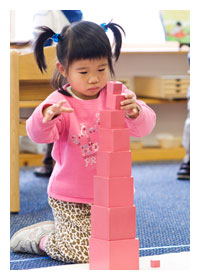 Offering vocabulary to
name the concepts learned: the Three Period Lesson. Throughout the
Montessori classroom, our teachers play an important role in helping our
students to put into words the knowledge they derive from their work
with the materials. The teacher observes her students working with a
material, and, in the words of Dr. Montessori, “when the child has
recognized the differences between the qualities of the objects, the
teacher fixes the idea of this quality with a word.” She does so in a
systematic process called the Three Period Lesson. First, she names an
object or attribute—”This is long. This is short.” Second, she asks the
child to hand her the corresponding object, and thus verifies whether he
has understood the concept: “Give me the long rod. Give me the short
rod.” Finally, she asks the student to pronounce the word, by holding up
the object and asking him: “What is this?” Thus, children learn to use
language precisely: They understand, implicitly, that concepts are not
woozy approximations or mere conventions, but precise identifications of
specific things or qualities in reality.
Offering vocabulary to
name the concepts learned: the Three Period Lesson. Throughout the
Montessori classroom, our teachers play an important role in helping our
students to put into words the knowledge they derive from their work
with the materials. The teacher observes her students working with a
material, and, in the words of Dr. Montessori, “when the child has
recognized the differences between the qualities of the objects, the
teacher fixes the idea of this quality with a word.” She does so in a
systematic process called the Three Period Lesson. First, she names an
object or attribute—”This is long. This is short.” Second, she asks the
child to hand her the corresponding object, and thus verifies whether he
has understood the concept: “Give me the long rod. Give me the short
rod.” Finally, she asks the student to pronounce the word, by holding up
the object and asking him: “What is this?” Thus, children learn to use
language precisely: They understand, implicitly, that concepts are not
woozy approximations or mere conventions, but precise identifications of
specific things or qualities in reality.